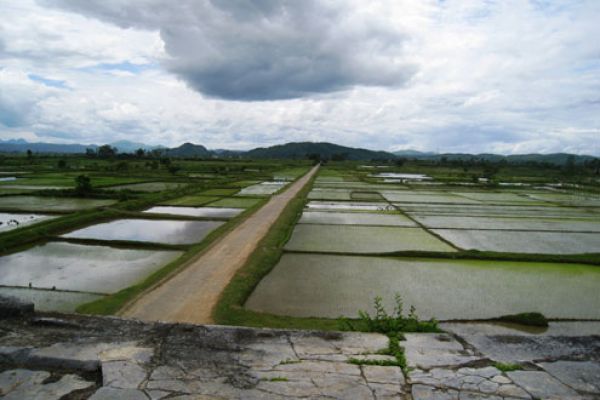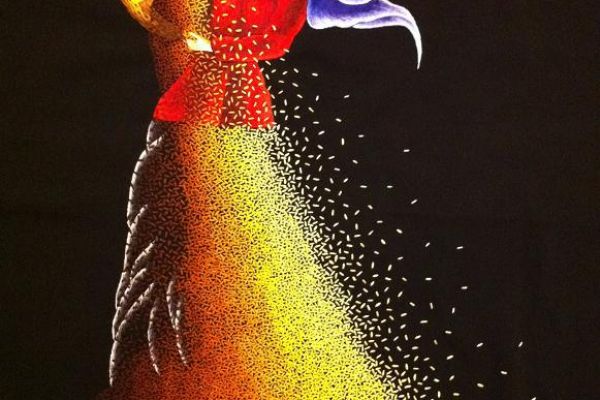Published: 15:35 Saturday - July 09, 2011

Ho Dynasty Citadel becomes world cultural heritage
Ho Citadel locates in adjacent to the four villages: lay Giai, Xuan Giai, Thuong Giai and Dong Mon in two districts Vinh Long and Vinh Tien, in Vinh Lac District, Thanh Hoa province. It was the capital of Vietnam from 1397 to 1407.
The citadel includes three sections: La Thanh and bamboo hedge; water trench and citadel wall; and internal area. The internal section has palaces such as: Hoang Nguyen, Nhan Tho, Phu Cuc, Dong Cung, Dong Thai Mieu, Tay Thai Mieu, Diem Canh,--with marble-paved roads connecting different palaces to each other.
The outside of the citadel are constructed works such as: Bao Thanh (Ly Cung) palace, altar of the sky and the earth, patterned-brick access to the sky and the earth altar, road from Thien ly (fragrant cynanthz) to Hoa Chau.
The citadel was constructed from 1397 to 1401, and some modification was continued in 1403.
This citadel was made by stone with huge quantity that had been taken from mountains in Tnaah Hoa.
Construction Method: Processed stone blocks were transported by timber rolls combined with stone balls (that were found recently) to reduce the friction. When the stone had to be moved to the height, earthen gradual sloping roads would be made to pull the stone, so whenever the stone wall was constructed the earthen wall also constructed. In order to build the citadel gates, an earthen gate frame was made first and then the stone moved to the top to form the gate. The soil would be moved away when construction work of the gate completed. The stone wall was fixed to each other without plaster as the weight press the stone with each other to make it firm. In case of the arch construction, the bending part would be trimmed as orange sections to make it pressed down each other firmly.
The stone citadel had been constructed based on a rectangular drawing with two edges South (front) and North (rear) of 900m long, and two edges East (left) and West (right) of 700m wide. Now only the stone block part with the height of 5 - 6m exists. The citadel has a diameter of 3508m, with walls of 5 - 6m high, except the wall near the Southern gate which is 10m. All the stone blocks were trimmed carefully into shaved square blocks with dimensions of 1.4 x 1 x 0.7m, and few of 4 x 1.2 x 1.2m and 5.1 x 1 x 1.2m. The citadel had four gates at the central of four edges South, North, East, and West.
The Southern gate is 34m long, 10m high, 15.6m thick which has been constructed with 3 curves as three-door temple gate, the middle curve is 8.5m high, the two others 7.8m. All of them are 5.Sm wide. Tops of the curves are paved with stones to form a surface with pile holes of wooden pillar architecture.
The Northern gate is 20.2m long, 7.5m high, 13.7m thick forming a curve which is over 6.6m high, 5.80m wide. Top of the curve are paved with stone forming a surface which is 12.7m w:3c and 20m long with circle pillar holes of 0.45m in diameter and 0.45n deep down stone level.
The Eastern gate is 23.3m long, 13.4111 thick, 5.7m wide forming a curve of 6.6m high.
The Western gate is 19.3m long, 13.4m thick, 5.7m wide forming a curve of 6.1m high.
The surrounding of the citadel in the northern direction, i.e. coming from the back gate, is the Earthen Elephant Mountain with the head looking at the South, and a bit further exist the Lai Mountain. The East of the citadel stands the Black Dog Mountain. The West of citadel looks at the Lying Buffalo Mountain. The South directs to the Don Son Mountain. It is also called Dun or Cung (Bow) mountain, as it is shaped as a bow directing at the citadel. Near the mountain there exists Ma (horse) river coming from the West and Bar River coming from the East.
These rivers are confluent at Huu Chap, catching the citadel in the middle. There still exists a couple of stone dragons at the gate carving flower string with two lines of flower leaves in both sides, leave lieads rolling into a circle with daisy flower form.
This is a typical decoration on stone of relics in Ly dynasty and early Tran dynasty. Square flower-carved bricks, with dimension of 35cm x 35cm, some brick without flower decoration but a rectangular sculptured deep into the brick with letters showing 15.2 location of brick production such as: Vinh Ninh, Huong Nhi commune, down-Yen Ton commune, etc.
Ho citadel is controlled by Thanh Hoa Relics and Landscape Management Board. The relics of Ho citadel have been classified as National relics since April 28, 1962. The management and protection here is easy as there is no residential area inside the citadel, but only land for rice cultivation.
As the citadel had been made by stone, it passed 600 of existence with the form almost as original. Only the residential buildings and royal palace inside the citadel had been collapsed and buried. At present, Ho citadel has been under restoration, renovated Some archaeological activities have lost been carried out, concretely the project cooperated with Japan to implement the researching work and excavation (since 2002) with the purpose of collecting, analyzing the documents in Vietnam and abroad on KO dynasty, Ho citadel; collecting and researching without photos to make clear the structure and existing citadel and the changes of citadel form together with surrounding areas through historical periods.
Ho citadel can be compared with other world citadel, ancient city and Derbent fortress which were pat of northern lines of the Sasanian Persian Empire in the East and West of the Caspian Sea.
The citadel was recognized by the UNESCO as a world cultural heritage site on June 27, 2011.
Thanh Hoa Province’s Vice Chair, Vuong Vat Viet said that the province would take many measure to preserve and develop the historical values of this relic.
Close-up to the Ho Citadel:






























(84-63) 3 826042 – (84-63) 3 511142
No 54 Nguyen Dinh Chieu, Ham Tien Central Mui Ne Beach Binh Thuan Vietnam
523 To Hien Thanh District 10 Ho Chi Minh City Vietnam
Ha Long Halong City Quang Ninh Vietnam
A13 Hung Thong 2 Halong City Quang Ninh Vietnam




